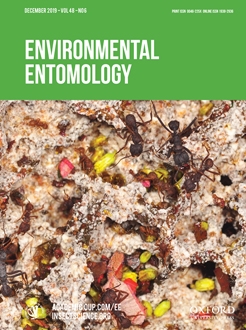Arthropods provide a variety of critical ecosystem services in agricultural landscapes; however, agricultural intensification can reduce insect abundance and diversity. Designing and managing habitats to enhance beneficial insects requires the identification of effective insectary plants that attract natural enemies and provide floral resources. We tested the attractiveness of 54 plant species with tolerance to dry soils, contrasting perennial forbs and shrubs native to the Great Lakes region to selected non-native species in three common garden experiments in Michigan during 2015–2016. Overall, we found 32 species that attracted significantly more natural enemies than associated controls. Among these, Achillea millefolium and Solidago juncea were consistently among the most attractive plants at all three sites, followed by Solidago speciosa, Coreopsis tripteris, Solidago nemoralis, Pycnanthemum pilosum, and Symphyotrichum oolantangiense. Species which attracted significantly more natural enemies at two sites included: Asclepias syriaca, Asclepias tuberosa, Monarda fistulosa, Oligoneuron rigidum, Pycnanthemum virginianum, Dasiphora fruticosa, Ratibida pinnata, Asclepias verticillata, Monarda punctata, Echinacea purpurea, Helianthus occidentalis, Silphium integrifolium, Silphium terebinthinaceum, Helianthus strumosus, and Symphyotrichum sericeum. Two non-native species, Lotus corniculatus, and Centaurea stoebe, were also attractive at multiple sites but less so than co-blooming native species. Parasitic Hymenoptera were the most abundant natural enemies, followed by predatory Coleoptera and Hemiptera, while Hemiptera (Aphidae, Miridae, and Tingidae) were the most abundant herbivores. Collectively, these plant species can provide floral resources over the entire growing season and should be considered as potential insectary plants in future habitat management efforts.
How to translate text using browser tools
8 November 2019
Screening Drought-Tolerant Native Plants for Attractiveness to Arthropod Natural Enemies in the U.S. Great Lakes Region
Daniel R. Gibson,
Logan Rowe,
Rufus Isaacs,
Douglas A. Landis
ACCESS THE FULL ARTICLE
It is not available for individual sale.
This article is only available to subscribers.
It is not available for individual sale.
It is not available for individual sale.

Environmental Entomology
Vol. 48 • No. 6
November 2019
Vol. 48 • No. 6
November 2019
beneficial arthropod
biological control-parasitoid & predator
habitat management
natural enemy




